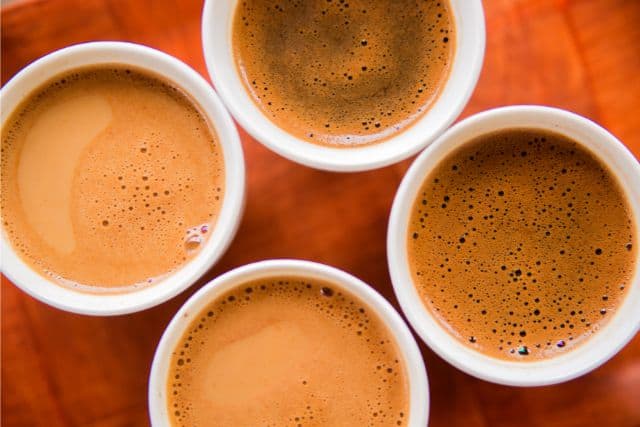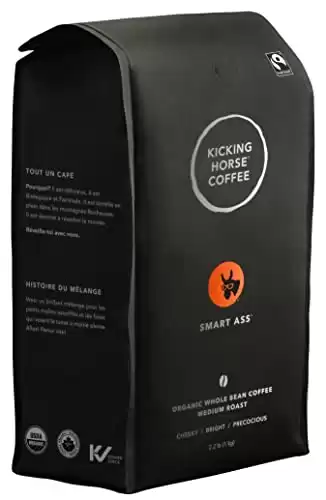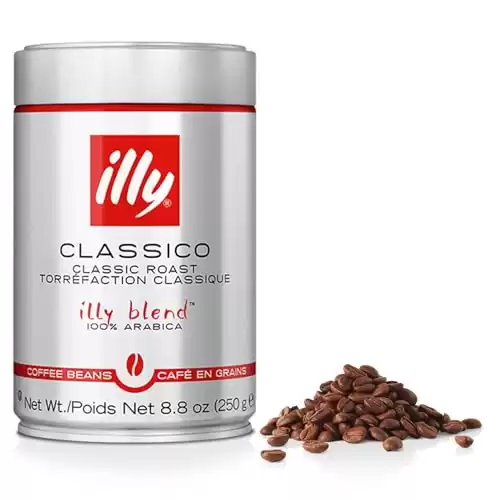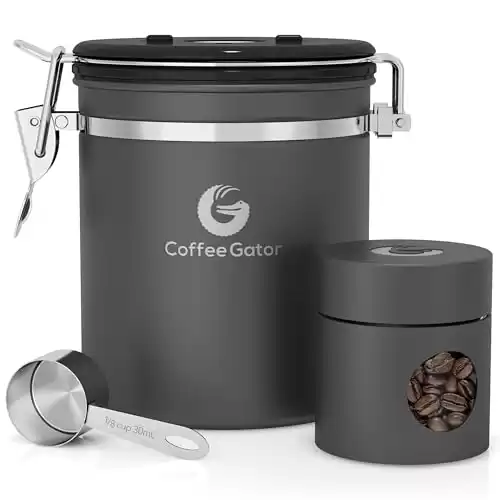Ever Wondered If Coffee Beans Packaging Is Really That Important?
This post contains affiliate links, which means we receive a small commission on qualifying purchases. This does not impact your cost in any way. See details here.

Coffee beans packaging is often overlooked, but it plays a crucial role in preserving the quality and freshness of coffee. The type of packaging used can greatly affect the taste and aroma of the beans, making it an important consideration for coffee producers and consumers alike.
There are several types of packaging used for coffee beans, including:
- paper bags
- foil bags
- vacuum-sealed bags
- cans
- glass jars
Each has its own advantages and disadvantages, and the choice ultimately depends on the specific needs and preferences of the consumer.
When choosing coffee beans packaging, there are several important factors to consider. These include:
- the shelf life of the beans
- airtightness of the packaging
- protection from light and moisture
- ease of use
- the environmental impact of the packaging material
The way coffee beans are packaged can also greatly impact their quality and freshness. Exposure to oxygen, light, moisture, and heat can all cause the beans to go stale and affect their taste. This is why proper packaging is essential for preserving the flavor and aroma of coffee beans.
To ensure that coffee beans stay fresh and flavorful, it is important to follow best practices for storing them. This includes keeping them in a cool, dark place, using an airtight container, avoiding freezing or refrigerating, and buying in small quantities.
In conclusion, the packaging of coffee beans is an essential aspect of the coffee industry. It not only helps to preserve the quality and freshness of the beans but also plays a role in consumer satisfaction. By understanding the different types of packaging, factors to consider, and best practices for storage, coffee lovers can ensure they are getting the best quality beans for their daily cup of Joe.
Why Is Coffee Beans Packaging Important?
The packaging of coffee beans plays a significant role in preserving their freshness and flavor. Here are a few reasons why packaging for coffee beans is crucial:
- Protection: Proper packaging safeguards coffee beans from being exposed to oxygen, moisture, light, and heat, all of which can degrade their quality.
- Freshness: Well-sealed packaging helps to retain the aroma and flavor of the beans, ensuring a fresh and enjoyable cup of coffee.
- Extended shelf life: Effective packaging methods, such as vacuum-sealing or nitrogen flushing, can prolong the shelf life of coffee beans.
- Convenience: User-friendly packaging, such as resealable bags or single-serve pods, offers convenience and ease of use.
Consider these suggestions for optimal coffee packaging:
- Use airtight containers.
- Opt for dark, opaque packaging to minimize light exposure.
- Look for roast dates on the packaging to ensure freshness.
What Are The Different Types Of Coffee Beans Packaging?
As we mentioned before, when it comes to coffee beans, the packaging plays a crucial role in preserving their freshness and flavor.
In this section, we will get into more detail, and discuss the various types of coffee beans packaging that are commonly used.
From traditional paper bags to modern vacuum-sealed bags, we will explore the pros and cons of each type. Whether you are a coffee connoisseur or simply looking to keep your beans fresh, understanding the different packaging options will help you make an informed decision.
1. Paper Bags
Paper bags are a popular choice for packaging coffee beans due to their affordability, recyclability, and breathability. To ensure the best results when using paper bags for coffee bean packaging, follow these steps:
- Choose high-quality paper bags with a strong barrier to prevent air and moisture from entering.
- Make sure the bags are lined with a food-grade material to maintain freshness and prevent any flavor contamination.
- Seal the bags tightly to preserve the aroma and flavor of the coffee beans.
- Store the bags in a cool, dark place to protect the beans from exposure to light and heat.
- Label the bags with the roast date and any other relevant information for easy identification and tracking.
2. Foil Bags
Foil bags are a popular type of packaging for coffee beans, offering several benefits in terms of preservation and freshness. Here are the key steps to consider when using foil bags:
- Choose High-Quality Foil Bags: Look for durable bags made from high-grade materials to ensure better protection.
- Airtight Seal: Make sure the bags have airtight seals to prevent any oxygen from entering and causing oxidation.
- Light and Moisture Barrier: Foil bags act as an effective barrier against light and moisture, which can degrade the quality of coffee beans.
- Storage Conditions: Store the foil bags in a cool, dark place away from direct sunlight and humidity to maintain optimal freshness.
By following these steps, you can take advantage of foil bags to preserve the flavor, aroma, and quality of your coffee beans for a longer period.
3. Vacuum-Sealed Bags
Vacuum-sealed bags are a popular type of packaging for coffee beans due to their ability to preserve freshness and flavor. Here are the steps involved in vacuum-sealing coffee beans:
- Roasting: After roasting the coffee beans to the desired level, allow them to cool.
- Grinding (optional): If you prefer to grind your own beans, do so before sealing to maintain freshness.
- Place the coffee beans in a vacuum-seal bag, leaving some space at the top for sealing.
- Sealing: Use a vacuum-sealer machine to remove the air from the bag and create an airtight seal.
- Labeling: Clearly label the bag with the roast date and any other relevant information, including the use of Vacuum-Sealed Bags.
Vacuum-sealed bags help prevent oxidation and the loss of volatile compounds, ensuring that the coffee beans stay fresh for a longer period of time. They also protect the beans from moisture, light, and other external factors that can degrade quality.
4. Cans
Cans are a popular type of packaging for coffee beans due to their numerous benefits:
- Airtightness: Cans provide excellent protection against oxygen, preserving the freshness of the beans.
- Light and moisture protection: Cans shield coffee beans from harmful light and moisture, preventing degradation of flavor and quality.
- Durability: Cans are sturdy and resistant to damage, ensuring that the beans remain protected during transportation and storage.
- Convenience: Cans are easy to open and reseal, allowing for repeated access to the beans without compromising their freshness.
Pro-tip: When choosing canned coffee beans, look for a can with a one-way valve that allows carbon dioxide to escape while preventing oxygen from entering, ensuring optimal freshness.
5. Glass Jars
When it comes to packaging coffee beans, glass jars offer unique advantages. While they’re not usually sold in glass containers, glass is used for storage.
Here is a list of things to consider when using glass jars for storing coffee beans:
- Choose a high-quality, airtight glass jar to preserve the freshness of the beans.
- Make sure that the glass jar has a rubber seal or airtight lid to prevent exposure to oxygen.
- Store the glass jar in a cool, dark place to protect the beans from light and heat.
- Avoid frequently opening the glass jar to minimize exposure to moisture.
- Consider purchasing coffee beans in smaller quantities to ensure maximum freshness.
By following these recommendations, you can effectively use glass jars to maintain the quality and freshness of your coffee beans.
What Factors Should Be Considered When Choosing Coffee Beans Packaging?
When it comes to coffee beans, the packaging plays a crucial role in preserving the freshness and quality of the beans. But with so many options available, how do you know which packaging is the best for your coffee beans? In this section, we will discuss the key factors that should be considered when choosing coffee beans packaging. These include shelf life, airtightness, protection from light and moisture, ease of use, and environmental impact. By understanding these factors, you can make an informed decision on the most suitable packaging for your coffee beans.
1. Shelf Life
To ensure the shelf life of coffee beans, proper packaging is essential.
Here are some things to consider the next time you buy coffee beans:
- Choose packaging that provides an airtight seal to prevent oxygen exposure.
- Opt for packaging that protects against light and moisture, as these can degrade the quality of the beans.
- Consider the convenience of the packaging, such as resealable bags or containers that are easy to open and close.
- Take into account the environmental impact of the packaging, opting for materials that are recyclable or biodegradable.
By following these steps, you can extend the shelf life of your coffee beans and enjoy a fresh cup of coffee every time.
2. Airtightness
Airtightness is a crucial factor to consider when selecting packaging for coffee beans. It plays a vital role in preserving the freshness and flavor of the beans for an extended period.
Here are some things to keep in mind when choosing packaging with airtight properties:
- Look for packaging materials such as foil bags or vacuum-sealed bags that provide an airtight seal.
- Ensure the packaging has airtight closures, such as zip locks or resealable lids.
- Select packaging that prevents oxygen from entering, as it can cause oxidation and spoil the coffee.
- Consider materials that are impermeable to external odors and moisture, maintaining the quality of the beans.
- Choose packaging that is designed to withstand pressure changes, protecting against air leaks.
During World War II, airtight packaging became essential for preserving the flavor and aroma of coffee beans during transport to soldiers on the battlefield. The invention of vacuum-sealed bags revolutionized the coffee industry and ensured that soldiers could enjoy a fresh cup of coffee even in challenging conditions.
3. Protection From Light And Moisture
To ensure the quality and freshness of coffee beans, it is essential to protect them from light and moisture.
Here are some points to consider when choosing coffee beans packaging:
- Opt for packaging materials that are opaque and light-proof to prevent exposure to light.
- Choose packaging with airtight seals to keep moisture from entering and affecting the beans.
- Consider packaging with moisture barriers, such as foil layers or special coatings, to further protect against moisture.
- Look for packaging that has a degassing valve to release excess carbon dioxide while preventing oxygen from entering.
- Consider packaging that provides a resealable feature to maintain freshness after each use.
Fact: Exposure to light and moisture can lead to oxidation and degradation of coffee beans, resulting in a loss of flavor and aroma.
4. Ease Of Use
Choosing coffee beans packaging that is easy to use is essential for convenience and maintaining the quality of the beans.
Here are some factors to consider:
- Accessibility: Opt for packaging that allows for easy access to the beans, such as resealable bags or jars with wide openings.
- Portability: Look for packaging that is lightweight and easy to carry, like compact bags or small containers.
- Sealing mechanism: Choose packaging with a reliable sealing mechanism to ensure freshness and prevent air or moisture from entering.
- Storage options: Consider packaging that can be easily stored in your kitchen, such as stackable bags or containers.
- Dispensing: Select packaging that allows for controlled pouring or scooping of beans without creating a mess.
5. Environmental Impact
When considering coffee beans packaging, it is crucial to consider its impact on the environment. Here are some steps to take for environmentally-friendly coffee beans packaging:
- Choose eco-friendly materials like paper bags or glass jars.
- Look for packaging that is recyclable or made from recycled materials.
- Opt for packaging that minimizes waste, such as vacuum-sealed bags that can be resealed.
- Consider the carbon footprint of the packaging, including transportation and production processes.
- Support brands that prioritize sustainability and have certifications like Fair Trade or Rainforest Alliance.
By making conscious choices about coffee beans packaging, you can help reduce the environmental impact of your coffee consumption.

How Does Packaging Affect The Quality And Freshness Of Coffee Beans?
When it comes to coffee, the packaging it comes in can have a significant impact on the quality and freshness of the beans. In this section, we will delve into the various factors that can affect coffee beans during the packaging process. From exposure to oxygen, light, moisture, and heat, each element plays a crucial role in preserving the flavor and aroma of coffee beans. By understanding the effects of packaging on coffee beans, we can make more informed decisions when choosing our favorite brew.
1. Exposure To Oxygen
Exposure to oxygen can have a significant impact on the quality and freshness of coffee beans. To minimize this exposure and prevent oxidation it is important to follow these steps:
- Choose a packaging option that includes a one-way valve, allowing carbon dioxide to escape without letting oxygen in.
- When opening the package, make sure to use the beans within two weeks to limit prolonged exposure to oxygen.
- If purchasing in bulk, it is recommended to divide the beans into smaller airtight containers to decrease contact with oxygen.
- Store the containers in a cool and dark place, away from direct sunlight and sources of heat.
2. Exposure To Light
Exposure to light can have a detrimental effect on the quality of coffee beans. To ensure the best possible flavor and aroma, follow these steps:
- Store in opaque containers: Use containers that block out light, such as ceramic jars or metal canisters.
- Avoid transparent packaging: Opt for bags or containers that do not allow light to pass through.
- Keep away from direct sunlight: Store coffee in a cool, dark place away from windows or other sources of direct light.
- Minimize exposure time: Limit the time coffee beans spend outside of their protective packaging to reduce exposure to light.
In the early days of coffee trade, coffee beans were often transported in jute sacks. However, it was soon discovered that exposure to sunlight during transportation and storage could have a negative impact on the flavor and aroma of the beans. This led to the development of packaging techniques that prioritize protecting coffee beans from light exposure, ensuring a fresher and more enjoyable cup of coffee.
3. Exposure To Moisture
Exposure to moisture is a crucial consideration when selecting packaging for coffee beans. Moisture can have a negative impact on the quality and freshness of the beans. To protect coffee beans from moisture, follow these steps:
- Choose packaging materials that are resistant to moisture, such as foil bags or vacuum-sealed bags.
- Avoid storing coffee beans in humid environments or near sources of water.
- Make sure the packaging is completely sealed to prevent moisture from entering.
- Consider using desiccant packets or moisture absorbers inside the packaging to absorb any excess moisture.
- Store coffee beans in a cool and dry place away from direct sunlight to further minimize exposure to moisture.
4. Exposure To Heat
Exposure to heat can significantly impact the quality and freshness of coffee beans. To ensure optimal preservation, follow these steps:
- Store in a cool place: Keep coffee beans away from direct heat sources, such as stovetops or near ovens.
- Avoid sunlight: Protect beans from direct sunlight, as it can increase temperature and affect flavor.
- Consider room temperature: Optimal storage temperature is around 70°F (21°C), avoiding extreme heat fluctuations.
- Use insulated containers: Insulated containers or airtight bags can offer additional protection from external heat, minimizing exposure to heat.
By following these steps, you can maintain the quality and flavor of your coffee beans by minimizing their exposure to heat.
What Are The Best Practices For Storing Coffee Beans?
As coffee lovers, we all know that the quality of our beans greatly affects the taste of our morning cup. But have you ever considered the role that proper storage plays in preserving the freshness and flavor of your coffee beans?
In this section, we will discuss the best practices for storing coffee beans to ensure that you are getting the most out of your beans. From keeping them in a cool, dark place to buying in small quantities, we’ll cover all the essential tips to maintain the quality of your coffee beans.
1. Keep In A Cool, Dark Place
Proper storage is crucial to maintain the freshness and flavor of coffee beans.
You should:
- Choose an airtight container to prevent exposure to oxygen.
- Store the container in a cool and dark area, away from direct sunlight.
- Avoid storing near heat sources like stoves or ovens.
- Keep the container away from moisture to prevent degradation.
By following these steps, you can ensure that your coffee beans stay fresh and delicious for a longer period of time.
2. Use An Airtight Container
To maintain the freshness and quality of your coffee beans, it is essential to store them in an airtight container.
Here are the steps to follow for maximum freshness when using an airtight container:
- Choose a container specifically designed for storing coffee beans.
- Ensure that the container has a tight-fitting lid to prevent air from entering.
- Transfer the coffee beans from their original packaging to the airtight container.
- Press down on the lid to create a seal and remove any excess air.
- Store the container in a cool, dark place away from direct sunlight and heat sources.
By using an airtight container, you can protect your coffee beans from exposure to oxygen, which can lead to flavor deterioration. Additionally, the airtight seal helps to prevent moisture and odors from affecting the taste of the beans.
3. Avoid Freezing Or Refrigerating
Freezing or refrigerating coffee beans is not recommended as it can negatively impact their quality and flavor.
Instead of freezing or refrigerating coffee beans, you should:
- Store in a cool, dark place: Find a spot away from direct sunlight and heat sources.
- Use an airtight container: Transfer the beans to an airtight container to prevent exposure to moisture and odors.
- Avoid temperature fluctuations: Keep the beans away from temperature changes caused by refrigeration.
- Buy in small quantities: Purchase coffee beans in small batches to ensure freshness and avoid the need for long-term storage.
Pro-tip: For optimal freshness, grind your beans just before brewing to preserve flavor and aroma.
4. Buy In Small Quantities
When it comes to purchasing coffee beans, it is best to buy them in smaller quantities to ensure the freshest and highest quality.
Here are some steps to follow:
- Buy the exact amount you need for a short period, typically 1-2 weeks.
- Choose local coffee roasters that offer freshly roasted beans in smaller quantities.
- Consider purchasing whole beans instead of pre-ground to maintain freshness for a longer period of time.
- Look for coffee bean packages with resealable features to keep the beans fresh after opening.
- Store the beans in an airtight container in a cool and dark place to prevent oxidation and maintain flavor.
See this article for more on keeping your beans fresh.

Frequently Asked Questions
What role do coffee bag valves play in preserving the freshness of coffee?
Coffee bag valves allow for the release of carbon dioxide while keeping oxygen, dust, and dirty air out. This helps prevent the coffee from becoming stale and maintains its aroma and taste.
What are the five main types of coffee packaging that utilize one-way valves?
The five main types of coffee packaging are stand up pouches, flat bottom bags, side gusset bags, quad seal bags, and tin-tie bags. Each type offers unique features and benefits for preserving the quality of coffee.
Why is it important to use one-way valves in coffee packaging?
One-way valves help prevent oxidation, which can cause coffee to become stale and lose its freshness. They also play a crucial role in extending the shelf life of coffee.
How does the roasting process affect coffee bag valves?
The roasting process can cause coffee beans to release carbon dioxide, which can lead to the bag puffing up or even bursting. This is why proper testing and packaging design, such as using one-way valves, are crucial for preserving the freshness of coffee.
What are the potential consequences of not using coffee bag valves?
Without one-way valves, coffee can lose its freshness and quality within just a few days. This can result in stale coffee and dissatisfied customers, which can ultimately hurt the reputation and profitability of a coffee shop or cafe.
How can coffee bag valves help with packaging and transporting coffee?
Coffee bag valves allow for degassing during the transportation process, which can be affected by factors such as midday traffic or changes in temperature. This helps to maintain the quality and freshness of coffee, making it the perfect choice for coffee shops, grocery stores, and individual consumers.








